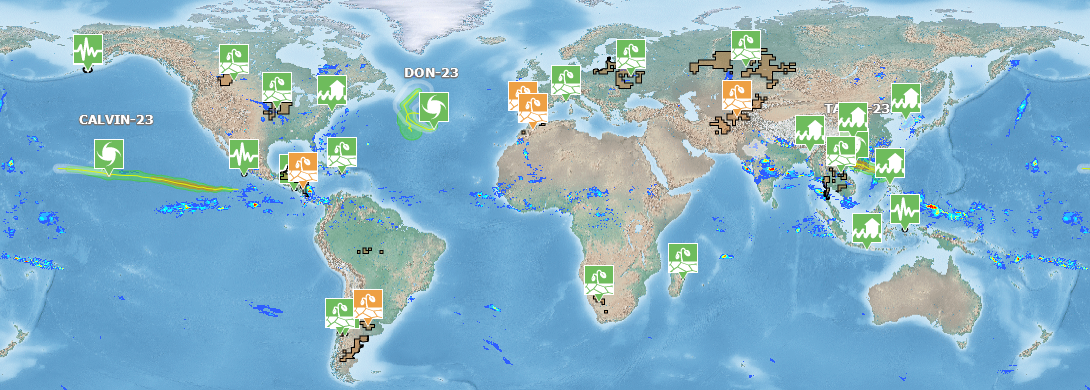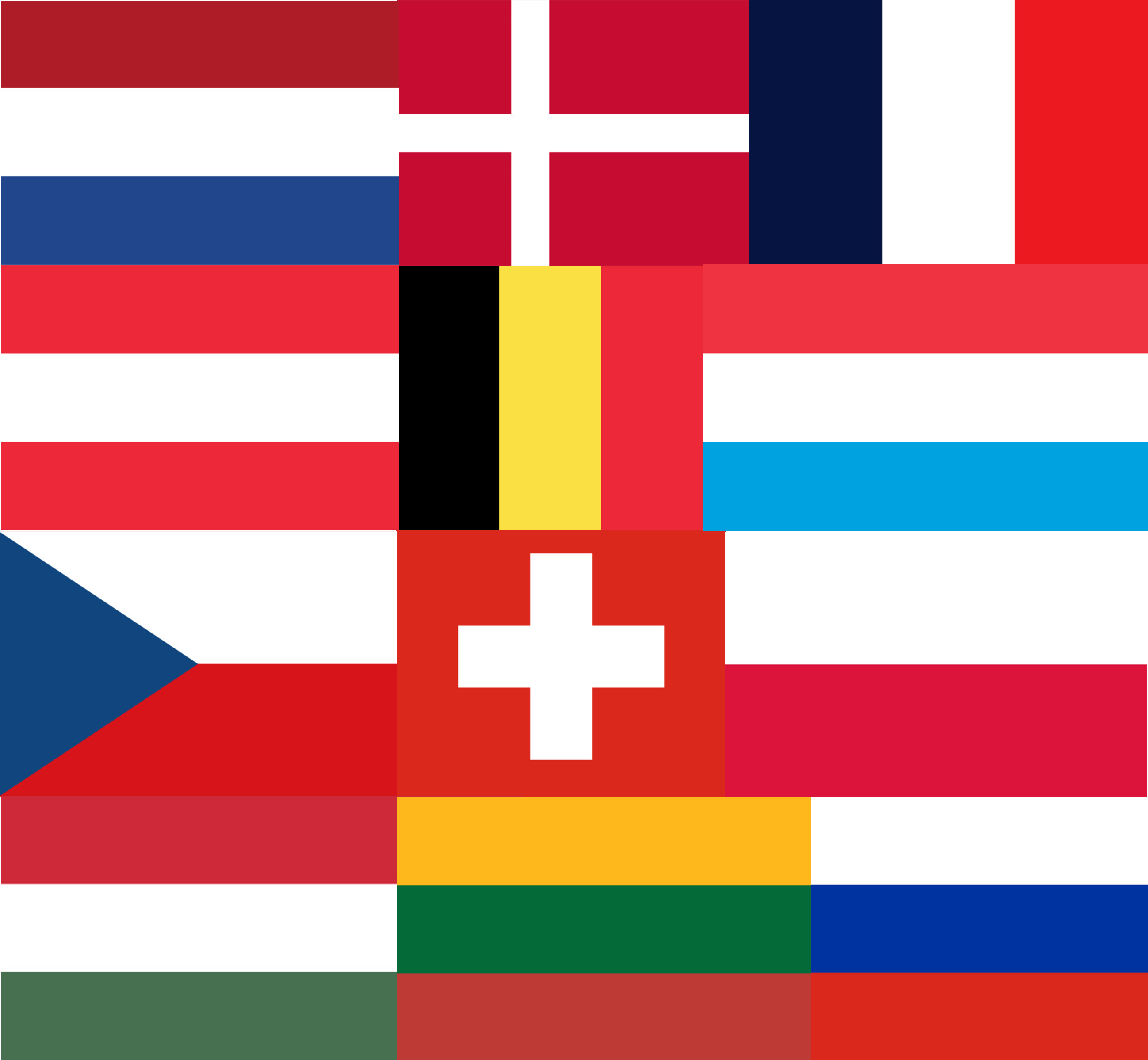Germany in International Disaster Management
Natural hazards and disasters are a challenge for people all over the world. For this reason, there are numerous international organisations that interact and are involved in many ways. This topic page provides an overview of the most important actors and Germany’s role in international disaster management.
© GDACS, 19.07.2023
International Disaster Management
The international environment is diverse and difficult to keep track of. Numerous players cavort in each individual subject area. To facilitate the overview, the topic page is structured along some categories of internationally active entities (Harvard Law School I & II, bpb):
| 1. | Bilateral Cooperation | usually manifested by direct agreements between two states on a specific topic and purpose. |
| 2. | Regional Intergovernmental Organisations | contractual association of two or more states of a certain region to work on common interests. |
| 3. | Global Intergovernmental Organisations | contractual association of states to which all states may accede as members. |
| 4. | International Non-Governmental Organisations | Organisations that represent political, social, societal and economic goals worldwide on the basis of private initiative. |
But how do these actors operate in international disaster management? How are they structured? What institutions are there for the transfer of knowledge? And how is Germany involved? These questions will be answered below. If you are particularly interested in an area, please use the link function in the overview above to directly jump there.
For those readers who work in the field of civil protection themselves, the page can provide an overview of the international actors and especially a practical overview of the numerous tools that can be used for cooperation and knowledge transfer.
.
Germany has concluded bilateral disaster relief agreements with all nine neighbouring countries (BEL, DNK, FRA, LUX, NLD, AUT, POL, CHE, CZE), as well as with Lithuania, Russia (currently suspended due to the Russian war of aggression on Ukraine (Federal Foreign Office) and Hungary (BBK). These agreements contain an obligation to cooperate, exchange information and provide mutual assistance, whereby assistance is understood as the dispatch of relief teams, equipment and supplies, e.g. to fight fires, CBRN hazards, medical assistance, rescue, recovery or makeshift repairs. The agreement enters into force when the partner state requests the assistance (DFV). In addition to contractual agreements, bilateral cooperation can also be realised on the basis of annual work programmes or memoranda of understanding (BBK), as well as taking place, for example, in various projects of GIZ and THW (under the auspices of the respective federal ministries).

According to the Lindau Agreement and Art 73, 74 of the Constitution, the ratification of bilateral treaties regarding civil protection (in the sense of defence in the case of war) is in principle the responsibility of the Federal Government (Bundestag), whereas in the case of disaster management treaties (response to natural hazards), the Federal States are usually asked for their consent. (Further information on civil protection in Germany can be found here).
.
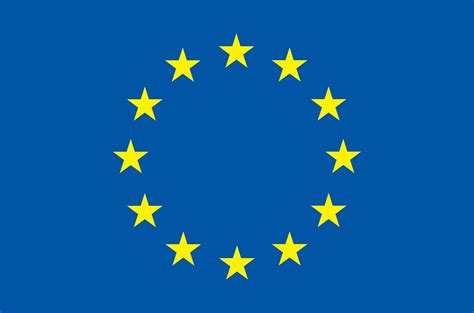
Directorate-General for European Civil Protection and Humanitarian Aid Operations
One of the most important regional organisations with German membership and an extensive disaster management system is the European Union. It has extensive departments and far-reaching possibilities to support disaster relief and preparedness.
The Directorate-General European Civil Protection and Humanitarian Aid (ECHO) of the EU Commission deals extensively with European cooperation on the subject. The Directorate-General runs the organisation of emergency management, disaster preparedness and preparedness, neighbourhood and international affairs, as well as general affairs (ECHO).

ECHO.A
Emergency Management and rescEU
Procedure of Emergency Management
Onset of a Disaster
Affected country can request assistance via the → Union Civil Protection Mechanism ←
► The Union Civil Protection Mechanism (UCPM) is the umbrella term for the functioning and procedures of the assistance that can be requested by an affected state in the event of a disaster. The resources of EU member states and participating states can be deployed in a targeted and pooled manner through this mechanism. Preparatory measures also fall under this term, more on this under ECHO.B (UCPM).
Facts
 Source: ERCC |
– Since its creation in 2001, more than 650 requests – 9 participating countries outside the EU: Albania, Bosnia-Herzegovina, Iceland, Montenegro, Northern Macedonia, Norway, Serbia, Turkey, Ukraine (not yet marked on the map). – Any country, UN agency, as well as the International Organisation for Migration (IOM), International Federation of Red Cross and Red Crescent Societies (IFRC) and the Organisation for the Prohibition of Chemical Weapons (OPCW) can request assistance from UCPM |
Example: UKRAINE
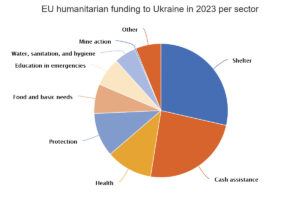 Source: ECHO | Ukraine |
On 14 February 2022, Ukraine made a first request to the Civil Protection Mechanism due to the aggravated situation. With this, the EU started to deliver essential goods to support the civilian population. Russia’s invasion on 24 February prompted the EU to mobilise all possible resources for emergency assistance, including the Civil Protection Mechanism. In spring 2022, logistics centres were set up in Poland, Romania and Slovakia to bring resources to Ukraine more quickly. Medical RescEU resources were provided and an expert team was stationed in Poland. The first medical evacuations from Ukraine took place in March. The EU Humanitarian Aid department (see ECHO C & D) also provided support in the form of another logistics centre in Kishinev (Republic of Moldova) with 1200 tents and 4000 blankets. Slovakia, Republic of Moldova, Poland and the Czech Republic also requested the Civil Protection Mechanism in the context of the invasion of Ukraine, including to cope with high numbers of refugees. On 20 April 2023, Ukraine became the latest partner state to join the European Civil Protection Mechanism. In June 2023, the European Civil Protection and Humanitarian Aid Mechanism provided 733 million euros, 48 million of which for refugees in the neighbouring Republic of Moldova. (ECHO | Ukraine) |
The → Emergency Response Coordination Center ← coordinates support
Facts
 Source: ERCC
Source: ERCC |
– At least three duty officers are available 24 hours a day – 106+ missions in 2022, inter alia to fight vegetation fires in Europe, COVID-19 worldwide, and the floods in Pakistan – Communication is organised via a web-based alert and messaging system: the Common Emergency Communication and Information System (CECIS) |
 Germany at ERCC
Germany at ERCC
↓ Participating states can get personnel support by ⇾EUROPEAN CIVIL PROTECTION POOL⇽
Process to register new resources to the pool
 Quelle: ERCC
Quelle: ERCC |
1. Application: contact points (in Germany: GMLZ) of all participating states can fill out the application form. 2. Certification: consists of an advisory visit, a table-top exercise (simulated scenario) and a field exercise (field report can be read ERCC | CP Pool here, p.9) 3. Registration in the pool: via the Common Emergency Communication and Information System (CECIS). (ERCC | CP Pool) |
 Germany in ECPP
Germany in ECPP
↓ Material support by ⇾RescEU⇽
Facts
 Source: ERCC
Source: ERCC |
– is an extension of the UCPM since 2019 – the reserve includes: Fleet of fire-fighting aircraft and helicopters, emergency medical teams and field hospitals, medical equipment and capacity for mobile laboratories, CBRN equipment (chemical, biological, radiological and nuclear incident detection, decontamination and stockpiling), temporary shelters, evacuation plans, transport and logistics. |
 Germany in rescEU
Germany in rescEU
↓ Scientific support by ⇾COPERNICUS EMERGENCY MANAGEMENT SERVICE⇽
Information Processing
 Post-disaster Soil Erosion Risk Assessment in Slovenia | Source: Copernicus
Post-disaster Soil Erosion Risk Assessment in Slovenia | Source: Copernicus |
– Emergency Mapping Service: can provide initial information on the impact of the disaster in terms of affected area and intensity in the first 2-10 hours after a disaster. – Risk and Recovery Mapping: in relation to floods, vegetation fires, humanitarian crises, landslides, land deformation, vulnerability. – Other specialised early warning services to support prevention and preparedness: European Flood Early Warning System (EFAS), European Forest Fire Information System (EFFIS), European Drought Observation (EDO). |
Speciality
Support arrives and is implemented

ECHO.B
Disaster Preparedness and Prevention
Disaster preparedness and prevention can reduce the impact of disasters. In order to achieve this and to enable cooperation between the participating countries, there is also a specialised department of the European Directorate-General for this purpose. It provides regular expert training and annual large-scale joint exercises of capacities from the civil protection pool. ECHO.B particularly supports those areas of civil protection where a common European approach is more effective than separate national measures. These include risk assessment, resilience research and strengthening early warning systems.
 European Disaster Management in Germany
European Disaster Management in Germany
↓ ⇾WISSENSZENTRUM FÜR KATASTROPHENRISIKOMANAGEMENT DRMKC⇽
🞂 In 2016, the EU Commission adopted a directive supporting the opening of knowledge and competence centres for specific topics. The knowledge centre on disaster risk management thus serves to further disseminate complex, multidisciplinary knowledge beyond the Directorate General. It facilitates better partnership working and supports innovation (DRMKC).
The Knowledge Centre processes the collected information in various offerings. These include:
| Risk Data Hub | collection of various analyses, data and reports |
| INFORM | for more information, see Knowledge Management, United Nations |
| Gaps Explorer | systematisation of gaps in the implementation of resilience measures, etc. with recommendations for stakeholders |
| Global Conflict Risk Index | assessment of the likelihood of violent conflict in specific regions |
| Projects Explorer | database with projects of different European actors on specific topics, e.g. for resilience and crisis management |
This also includes the EU CIVIL PROTECTION KNOWLEDGE NETWORK
🞂 The main tasks of the knowledge network are capacity development and the exchange of research results. In this sense, it acts as a knowledge exchange platform between experts, promotes research and innovation, and facilitates the joint participation of international participants, governmental and non-governmental organisations, as well as political, scientific and technical experts.
Activities of the knowledge network are e.g. the organisation of training, exchange and lessons learnt programmes, supranational exercises, workshops and conferences, as well as the coordination of scientific advice (CivProKnowNet).

ECHO.C & ECHO.D
Neighbourhood and International Affairs
ECHO.C & ECHO.D are the departments of the Directorate-General that deal with the worldwide Humanitarian Aid of the EU and coordinate it. The European Consensus on Humanitarian Aid (2007) defines Humanitarian Aid as:
► „Needs-based emergency assistance […] to save lives and prevent and alleviate human suffering in crisis situations caused by man or natural disasters. […] Humanitarian aid is based on the humanitarian principles of humanity, neutrality, impartiality and independence“ (European Consens on Humanitarian Aid).
In contrast to Disaster Relief, Humanitarian Aid is not applied within the EU, but serves to support other states in the event of a disaster or crisis. Disaster Relief is also designed for a shorter period of time. For the EU, Humanitarian Aid also differs from the UCPM in that its main task is to provide and manage financial resources. This means that after a disaster occurs, the EU first makes an initial assessment of the situation on the ground and then releases funds accordingly to non-governmental organisations, United Nations agencies and international organisations to implement Humanitarian Aid. Only in exceptional cases, when these traditional means are insufficient or ineffective, will the resources of the European Humanitarian Response Capacity (EHRC), the European Solidarity Corps (a volunteer programme) or the European Civil Protection Mechanism be used (European Parliament).
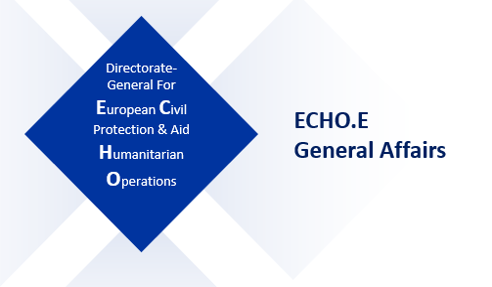
ECHO.E
General Affairs
 Sources: 2001, 2012, 2013, 2016, 2019
In addition, the EU also refers to various international agreements: the Sendai Framework for Disaster Risk Reduction 2015-2030, the Paris Agreement 2016, and the United Nations 2030 Agenda for Sustainable Development (Decision No 1313/2013/EU).
Sources: 2001, 2012, 2013, 2016, 2019
In addition, the EU also refers to various international agreements: the Sendai Framework for Disaster Risk Reduction 2015-2030, the Paris Agreement 2016, and the United Nations 2030 Agenda for Sustainable Development (Decision No 1313/2013/EU).
Euro-Atlantic Disaster Response Coordination Centre
► Another important regional intergovernmental organisation with German participation is NATO (North Atlantic Treaty Organization). Even though its tasks are mainly in the field of civil protection, NATO also takes on disaster management tasks. The most important tool in this context is the Euro-Atlantic Coordination Centre for Disaster Relief. This is a coordination centre that mediates requests for assistance to member and partner states in the event of a disaster and coordinates offers of support. The centre can also provide support in political crises and Article 5 alliance situations (i.e. in the case of civil defence). The EADRCC describes itself as a complement to UN OCHA – you can read more about UN OCHA in the next section (NATO).

© NATO, Senior Resilience Officials’ Meeting, 16.11.2022
Resilience Committee
Another NATO instrument is the Resilience Committee. The Permanent Representatives of the member states meet there weekly and report directly to the North Atlantic Council. The six planning groups Civil Communications, Civil Defence, Energy Planning, Food and Agriculture Planning, Joint Health and Transport support the Committee with their expertise (NATO).
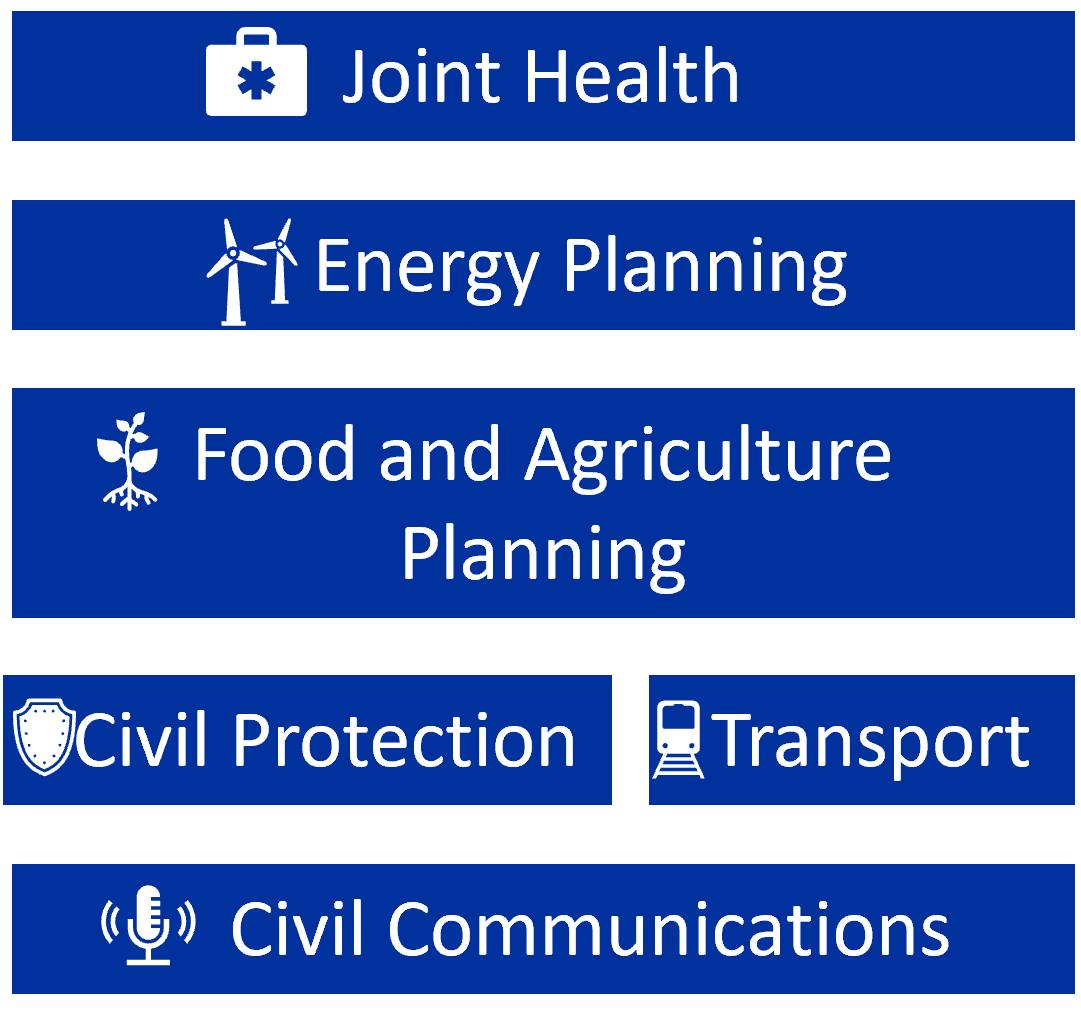
.
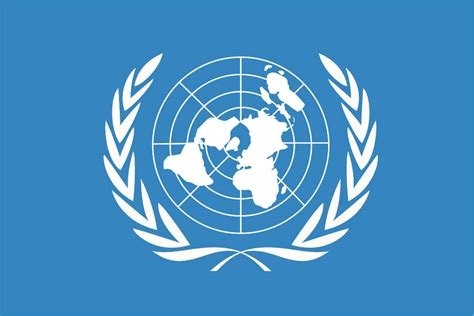
United Nations
The United Nations (UN) have responsibilities in countless international affairs, and thus also deal with disaster management. There are fewer clear demarcations between civil protection and humanitarian aid here than in the EU, which is why UN OCHA, for example, also takes on disaster management tasks, and many other UN organisations are also active in this area. The following is therefore a non-exhaustive extract of the institutions that deal with disaster management in one way or another, as well as the platforms that serve to coordinate knowledge and information. Institutions that are not explicitly listed but nevertheless support UN disaster response include the United Nations High Commissioner for Refugees (UNHCR) and the United Nations Children’s Fund (UNICEF).
Relevant Institutions

© pixabay
UNDRR: United Nations Office for Disaster Risk Reduction
► The UNDRR’s main tasks are risk knowledge management, analysis and monitoring, and capacity development. The office also coordinates the implementation of the Sendai Framework.
 Germany at UNDRR
Germany at UNDRR
The National Contact Point (Nationale Kontaktstelle NKS) for the Sendai Framework is located at BBK and coordinates German implementation, advises, networks actors, informs the public and reports progress to the UN (BBK | NKS).
UN OCHA: United Nations Office for the Coordination of Humanitarian Affairs
► UN OCHA is responsible for coordinating global emergency response in the event of humanitarian crises and disasters.
Of the Office’s tasks, some belong to the field of civil protection (UN OCHA):
© United Nations Office for the Coordination of Humanitarian Affairs
 |
 |
 |
 |
 |
 |
| Evaluation and review after disasters | Humanitarian access (e.g. through humanitarian corridors in war zones) | Civil-military cooperation | Needs assessment and analysis | Work with governments (policy advice and recommendations) | Preparedness and risk management (in terms of own resources, coordination system, mobilisation of resources members) |
Essential to the functioning of UN OCHA is the United Nations Disaster and Coordination (UNDAC) process, which can support with task forces, systematised procedures and resources (UN OCHA).
The International Search and Rescue Advisory Group (INSARAG) is also based here. Its goal is to improve the conditions for and the cooperation of international urban search and rescue teams that search for missing persons after an earthquake, for example. Among other things, INSARAG provides guidelines for this purpose, so that all those providing assistance observe the same conditions during the operation (INSARAG).
 Germany at UN OCHA
Germany at UN OCHA
Germany is a donor to international Humanitarian Aid in general and to UN OCHA in particular. In addition, representatives are active in the decision-making bodies (Auswärtiges Amt).
UNDP: United Nations Development Programme
► The UNDP sees resilience as one of its most important tasks. This includes, among other things, monitoring multidimensional risks by UN regional offices and supporting early warning and preparedness in many countries. The development programme also emphasises the relevance of resilient reconstruction plans and works on risk-informed development in general (UNDP | Resilience).
WHO: World Health Organisation
► WHO addresses the health impacts of disasters such as droughts, earthquakes, floods, heat waves, landslides, tropical cyclones, volcanic eruptions, and wildfires. It is involved in sending medical support after disasters and providing financial resources. In the long term, WHO is working with member states on resilient structures (WHO).
WMO: World Meteorological Organisation
► The WMO is a UN specialised agency for the coordination of international cooperation in all areas dealing with the Earth’s atmosphere and its interaction with land and ocean, weather and climate, and the distribution of water resources. One focus is on natural hazards and disaster risk reduction. In this context, the WMO supports national meteorological and hyrological organisations, e.g. in improving forecasting services and early warnings as well as risk assessments, and strengthens cooperation and knowledge exchange at the international level (WMO).
 Germany at WMO
Germany at WMO
The Permanent Representative of Germany to the WMO is the President of the German Meteorological Service, appointed by the Federal Foreign Office. The Permanent Representations of the Member States meet once a year in the Executive Council to steer the activities of the organisation. From 2019 to 2023, the President of the DWD at that time, Prof. Dr. Adrian, was elected WMO President and thus presided over the WMO Congress, chaired meetings and oversaw activities. Various German experts are active in WMO working groups (DWD).
World Bank Group and Global Facility for Disaster Reduction and Recovery GFDRR
► The World Bank Group also consists of UN specialised agencies. Also the GFDRR is under its leadership and primarily provides financial support for the most vulnerable countries with a high risk potential. It finances technical assistance, expertise brokerage, analyses and innovative solutions. (GFDRR).
IPCC: Intergovernmental Panel on Climate Change
► The IPCC, founded by the WMO and the United Nations Environment Programme (UNEP), publishes the globally recognised annual scientific “Assessment Report” on the impacts and current status of climate change, as well as on possible mitigation and adaptation measures. It also examines the influence of climate change on the frequency of extreme weather events and presents the risks. (IPCC Report 6 2023).
 Germany at IPCC
Germany at IPCC
The German Coordination Unit of the IPCC has been set up at the German Aerospace Center (Deutsches Zentrum für Luft- und Raumfahrt DLR) as a project management agency on behalf of the Federal Foreign Office. The task of the Coordination Unit is to support the contribution of German climate scientists to the Assessment Reports, to disseminate information from the IPCC, and to support the IPCC itself. (Deutsche IPCC-Koordinierungsstelle).
PreventionWeb
► PreventionWeb’s mission is to disseminate and facilitate access to disaster risk reduction information. It is a UNDRR platform that serves as a comprehensive knowledge base – explaining disaster risk reduction concepts and terms, publishing research on risks, current developments, natural hazards and past disasters, and organising educational activities such as workshops (PreventionWeb).
reliefweb
► The task of reliefweb, a platform of UN OCHA, is to process and collect global contributions such as reports, maps and infographics that contain information on specific humanitarian situations. The aim of making this information available is to improve informed decision-making for staff in all humanitarian sectors. The ReliefWebResponse section also collects information on existing global responses, sorted by region and emergency. Sources include humanitarian organisations, governments, think tanks, research institutions and the media (reliefweb).
GDACS: Global Disaster Alert and Coordination System
► One of the tasks of GDACS is to share maps and satellite images that various agencies make available for everyone’s information. The platform, a cooperation between the United Nations and the EU, also disseminates disaster warnings to about 25,000 subscribers based on risk analyses by the European Joint Research Centre. Particularly in the initial phase of a disaster, GDACS enables the coordination of different actors and the exchange of information (GDACS).
INFORM: Index for Risk Management
► The platform is a joint initiative of the Inter-Agency Standing Committee Reference Group on Risk, Early Warning and Preparedness, part of UN OCHA, and the European Commission. The aim is to make information on the risk of humanitarian crises widely available. (INFORM).
Several tools are provided (INFORM):
- INFORM Risk Index creates disaster risk profiles of many countries based on vulnerability, hazard potential and probability, and coping capacities (INFORM Risk).
- INFORM Warning provides information on existing alert systems and prevention practices as a basis for decision-makers.
- INFORM Severity Index enables the assessment of the severity of a humanitarian crisis based on its impact, the conditions of those affected and its completeness (INFORM Severity).
- INFORM Climate Change Risk Index includes climate and socio-economic factors in the risk analysis.
Knowledge Management

.

Internationale Non-Governmental Organisations
In addition to state-coordinated and funded organisations, it is a large number of non-governmental organisations that provide a large part of the disaster response at the international level. They are mostly coordinated by regional offices, but some of them have international capacities that can be called upon in the event of a disaster as part of Humanitarian Aid, i.e. short-term support after a crisis event, and can often be on the ground within a few hours. Since it is impossible to present all of them, the following is a look at the best-known organisation and an umbrella organisation that unites many actors.

International Red Cross and Red Crescent Movement
► Probably the best-known non-governmental organisations in the world are those of the International Red Cross and Red Crescent Movement. These include the International Federation of the Red Cross and Red Crescent Societies (IFRC) and the International Committee of the Red Cross (ICRC). The former is composed of 192 National Red Cross and Red Crescent Societies (IFRC). The extensive movement can thus easily be described as the “most prominent non-state actor in international disaster relief” (Tometten, C. (2007), p.4).
Speciality:
The ICRC is the only organisation directly mentioned in the Geneva Conventions (I, Art. 3, 10 and 53; II, Art. 11; III, Art. 3, 9 and 11; IV, Art. 10, 12, 14 and 143, and Additional Protocol of 12 August 1949) and is thus a specific and explicit part of international humanitarian law. (Tometten, C. (2007), p.4)

![]() The German Red Cross also provides inter
The German Red Cross also provides inter
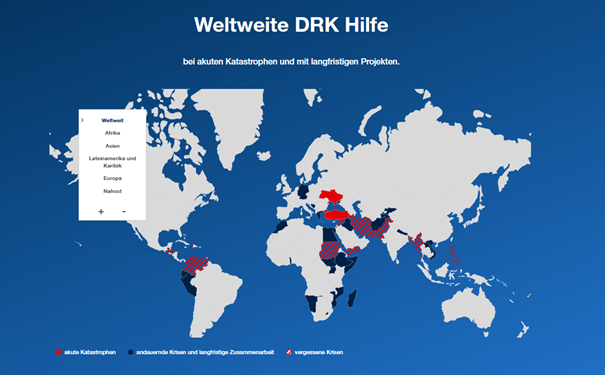
© DRK, 09.08.2023
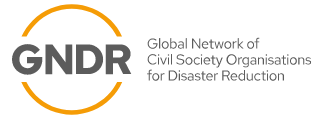
Global Network of Civil Organisations for Disaster Reduction
► Members of the GNDR are NGOs, foundations, community groups and non-profit organisations whose aim is to support and strengthen communities at increased risk. The focus of the network is to support community-based disaster risk reduction and risk-based approaches. The aim is, among other things, to improve members’ access to decision-making levels, to enable local research, and to support the creation of resilience plans (GNDR).
 Deutschland und das DKKV beim GNDR
Deutschland und das DKKV beim GNDR
Since 2020, DKKV has been the national contact point for Germany and regularly participates in advisory board meetings with other European contact points. You can find more information on our page “Networks and Cooperations“.
Germany in International Disaster Management
International disaster management is an extensive field in which many different actors take on numerous tasks. Germany is also active internationally in this context, whether through bilateral cooperation, within the framework of the EU and NATO or the United Nations. German non-governmental organizations are also involved in disaster management worldwide. You have gained an overview of all these institutions on the topic page, as well as of internationally available tools for knowledge transfer and coordination.
Further Links
- Federal Office of Civil Protection and Disaster Assistance: Multilateral Cooperation
- Federal Foreign Office: humanitarian Disaster Risk Reduction
- UNDRR: German National Platform
- ECHO: Overview of national disaster management systems
Current Information
No Results Found
The page you requested could not be found. Try refining your search, or use the navigation above to locate the post.


